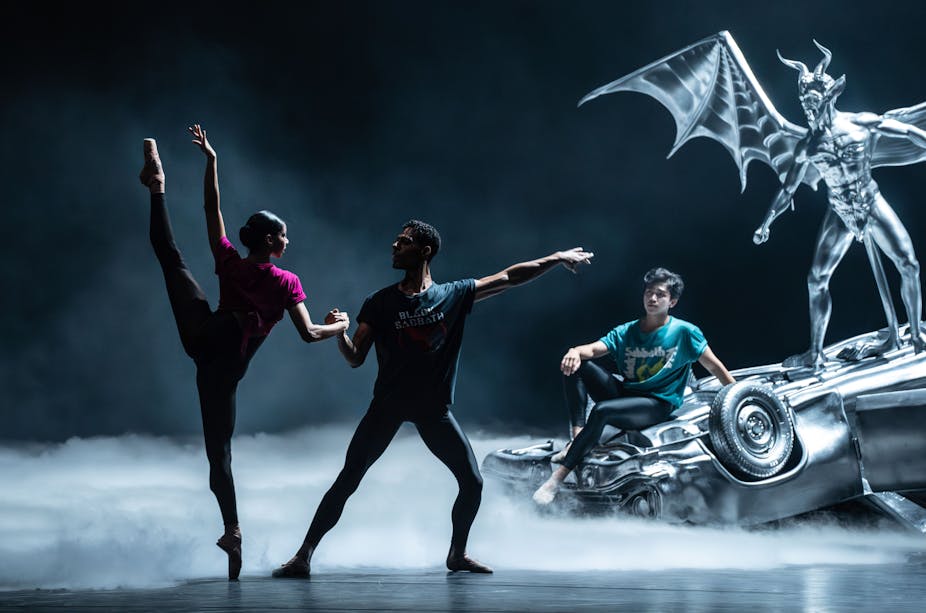Ballets are typically performed to the enchanting and distinctive melodies of classical music, not the emphatic beats and supersonic volume of heavy metal. But it’s the music of heavy metal pioneers Black Sabbath that scores Birmingham Royal Ballet’s new show, Black Sabbath – The Ballet, which is currently showing at the Theatre Royal Plymouth before moving to London’s Sadler’s Wells.
Ballet, and the classical music that usually accompanies it, symbolises elegance and sophistication – the epitome of high culture. Heavy metal music is often regarded as the exact opposite, and its fans have been treated in a similar fashion: viewed as unsophisticated.
When I was doing research on identity expression in heavy metal music for my PhD, I was often met with apathy from people who did not care about the music or the culture. They’d ask: “Why bother doing research on this?”
I must admit that going into Black Sabbath – The Ballet, I had my own doubts. My knowledge and experience of ballet was nonexistent, and I was expecting little more than some dancing around to Black Sabbath’s music. But I was very pleasantly surprised that it was more than that – it was a spectacle of entertainment.
Performing the ballet
A short piano introduction to Iron Man (1972) opens the show, as dancers dressed entirely in black enter the stage. Then, a guitarist – dubbed the Guitar Spirit – plays the chords to Iron Man, now accompanied by the orchestra. The dancers cavort around him, picking him up and carrying him around the stage as he plays.
As the song finishes and fades, an orchestral cover of Solitude (1971) accompanies two dancers sharing a kiss that lasts throughout the song. Their bond is only broken by the return of the Guitar Spirit, now playing the riffs of Paranoid (1970).

The second act features voiceovers from members of Black Sabbath, including an account of guitarist Tony Iommi’s factory accident which affected his guitar playing – and how he persevered through this struggle. There’s also commentary about the band parting ways with lead singer Ozzy Osbourne, their rise to fame, struggles with drugs and alcohol and the subsequent difficulties of stardom.
This act, telling the story of four young men from Aston in Birmingham becoming musical icons, concludes with a powerful orchestral arrangement of Sabbath Bloody Sabbath (1973). The story is told clearly, underpinned by sombre and melancholic orchestral music that successfully adds a sense of nostalgia.
The final act focuses on the legacy of Black Sabbath, their influence on heavy metal music, how music brings people together, and how the band is celebrated all over the world. It includes a nice flute piece inspired by the connection the band shares with its fans, accompanied by some occasional light, rhythmic drum beats to perhaps emulate the conditions the band experienced working in a factory before their rise to fame.

Then, the Guitar Spirit returns and the mood of the music changes. Playing Laguna Sunrise (1971), the Guitar Spirit and a dancer take turns to command the audience’s attention. The music builds up in a grandiose interplay with the orchestra – everyone plays their part to lead the audience to the climax of the ballet.
As Paranoid begins to be played for the last time, Iommi himself takes to the stage in a surprise appearance (he only appears in a handful of performances of the ballet) and rocks out with the Guitar Spirit.
A fitting celebration
Black Sabbath – The Ballet beautifully coalesces the elegance of classical music and ballet with the gritty and aggressive nature of heavy metal music.
Ballet may look fluid and effortless, but it demands years of hard physical and mental work. In this way, it mirrors the experience of being in a band: hard work which eventually results in success, despite strain and downsides. The fusing of the classical orchestra with the music of Black Sabbath makes this ballet a phenomenal experience.

Looking for something good? Cut through the noise with a carefully curated selection of the latest releases, live events and exhibitions, straight to your inbox every fortnight, on Fridays. Sign up here.

